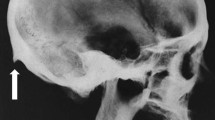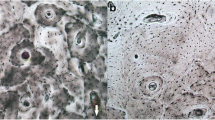Abstract
The main aim of our work was to evaluate osteometry as a complementary tool for the early detection of Ammotragus lervia, an exotic ungulate, which currently shows an expanding trend in southeastern Spain. For this purpose, 142 metacarpi and 123 metatarsi from seven Iberian ungulate species were determined by means of a classification function. In a general way, this function works, but regarding related species (those very similar from a morphometrical view), correct determination was reached in only 44.4–90% of the cases. However, in these cases, we can use auxiliary criteria like sexually dimorphic traits, and reach 100% correct identification of bones.






Similar content being viewed by others
References
Adamczewski JZ, Gates CC, Hudson RJ (1987) Fat distribution and indices of carcass composition in Coats Island caribou (Rangifer tarandus groenlandicus). Can J Zool 65:368–374
Adams LG (2003) Marrow fat deposition and skeletal growth in caribou calves. J Wildl Manag 67:20–24
Ashley EP, McCullough GB, Robinson JT (1998) Morphological responses of white-tailed deer to a severe population reduction. Can J Zool 76:1–5
Baksi SN, Newbrey JW (1989) Bone metabolism during antler growth in female reindeer. Calcif Tissue Int 45:314–317
Ballard WB, Whitman JS (1987) Marrow fat dynamics in moose calves. J Wildl Manag 51:66–69
Blood DA, Lovaas AL (1966) Measurements and weight relationships in Manitoba elk. J Wildl Manage 30:135–140
Blumenschine RJ, Madrigal TC (1993) Variability in long bones marrow yields of east African ungulates and its zooarchaeological implications. J Archaeol Sci 20:555–587
Boessneck J (1969) Osteological differences between sheep (Ovis aries Linné) and goat (Capra hircus Linné). In: Brothwell D, Higgs E (eds) Science in archaeology, 2nd edn. Thames and Hudson, London, pp 331–358
Boutin J-M, Gaillard J-M (1992) Discrimination de deux classes d’âge chez le Chevreuil (Capreolus capreolus) par la mesure de la longueur du pied arriére. Game Wildl Sci 9:95–104
Brooks PM, Hanks J, Ludbrook JV (1977) Bone marrow as an index of condition in African ungulates. S Afr J Wildl Res 7:61–66
Cassinello J (2000) Ammotragus free-ranging population in the south-east of Spain: a necessary first account. Biodivers Conserv 9:887–900
Cassinello J, Serrano E, Calabuig G, Pérez JM (2004) Range expansion of an exotic ungulate (Ammotragus lervia) in southern Spain: ecological and conservational concerns. Biodivers Conserv 13:851–866
Crampe J-P (1997) Caractéristiques bio-demographiques d’une populatión d’isards (Rupicapra p. pyrenaica) dans le Parc National des Pyrénées, en vallée de Cauterets. Documents scientifiques du Parc National des Pyrénées 31:1–165
Davis AJM (1987) The archaeology of animals. Yale University Press, New Haven, Connecticut, USA
De la Peña J, Brugarolas C (1983) El árrui(Ammotragus lervia) en la Reserva Nacional, de Caza de Sierra Espuña (Murcia-España). Informe inédito 1–6
Delibes M (1986) Ammotragus lervia (Pallas, 1777). Mähnenschaf. In: Niethammer J, Krapp F (eds) Handbuch der Säugetiere Europas, pp 422–431
Fandos P, Vigal CR, Fernandez-Lopez JM (1987) Weight estimation of Spanish ibex, Capra pyrenaica, and Chamois, Rupicapra rupicapra (Mammalia, Bovidae). Mamm biol 54:239–242
Fuller TK, Coy PL, Peterson WJ (1986) Marrow fat relationships among leg bones of white-tailed deer. Wildl Soc Bull 14:73–75
Gabler KO (1985) Osteologische Unterscheidungsmerkmale am postkranialen Skelett zwischen Mähnenspringer (Ammotragus lervia), Hausschaf (Ovis aries) und Hausziege (Capra hircus). Institut für Paläoanatomie Domestikationsforschung und Geschichte der Tiermedezin der Universität München, München-Germany
Gállego L (1999) Sobre el determinismo de la forma en Anatomía. VII Conferencia Española de Biometría, pp 307–310
Gállego L, Sánchez A (1996) La craniometría de los quirópteros en el trabajo de GS Miller 1912. Bol R Soc Esp Hist Nat 96:139–145
Gállego L, Mira P, Pou N, Lambea R (1996) La biometría y la informática, herramientas para la determinación de piezas anatómicas. Historia Natural 93, Instituto de Estudios Altoaragoneses - Instituto Pirenáico de Ecología (C.S.I.C.), Jaca, pp 309–318
Gállego L, Linde M, Bemvenuti MA (1998) Aplicación práctica del uso de una función de clasificación para determinar especies del género Odontesthes (Osteichthyes, Atherinidae). Bol R Soc Esp Hist Nat 94:105–111
Gingerich PD (1990) Prediction of body mass in mammalian species from long bone lengths and diameters. Contrib Mus Paleontol Univ Mich 28:79–92
Gonzalez G, Crampe J-P (2001) Mortality patterns in a protected population of isards (Rupicapra pyrenaica). Can J Zool 79:2072–2079
Granados JE, Pérez JM, Soriguer RC, Fandos P, Ruiz-Martinez I (1997) On the biometry of the Spanish ibex Capra pyrenaica, from Sierra Nevada (Southern Spain). Folia Zool 46:9–14
Habermehl K-H (1992) Die Altersbeurteilung beim weiblichen Steinwild (Capra ibex ibex L) anhand der Skelettentwicklung. Anat Histol Embryol 21:193–198
Hall-Martin AJ (1977) Giraffe weight estimation using dissected leg weight and body measurements. J Wildl Manag 41:740–745
Kardong KV (1998) Vertebrates. Comparative anatomy, function, evolution. McGraw-Hill, New York
Klein DR, Meldgaard M, Fancy SG (1987) Factors determining leg length in Rangifer tarandus. J Mamm 68:642–645
Kurten B (1955) Sex dimorphism and size trends in the cave bear, Ursus spelaeus Rusenmüller and Heinroth. Acta Zool Fennica 90:252–264
Lewall EF, Cowan IMcT (1963) Age determination in black-tail deer by degree of ossification of the epiphyseal plate in the long bones. Can J Zool 41:629–636
McMahon TA, Bonner JT (1983) On size and life. Scientific American Library, New York
Michallet J, Loison A, Gaillard JM (1996) Valeur de criteries biometriques externes pour la role de l’habitat dans le developpement biometrique du bouquetin des Alpes (Capra ibex ibex). Ibex 2:1–8
Ransom AB (1965) Kidney and marrow fat as indicators of white-tailed deer condition. J Wildl Manag 29:397–398
Robbie MA, Vaughan N (1999) An efficient way to prepare mammalian skulls and bones. Mammal Rev 24:65–66
Serrano E, Calabuig G, Cassinello J, Granados JE, Pérez JM (2002a) Corología del Árrui Ammotragus lervia (Pallas, 1777) en el Sureste Peninsular. Galemys 14:17–29
Serrano E, Calabuig G, Cassinello J, Pérez JM (2002b) The human dimensions that favours the unnatural expansion of an exotic ungulate (Ammotragus lervia) throughout the Iberian Peninsula. J Mountain Ecol (Pirineos) 157:181–189
Serrano E, Granados JE, Pérez JM, Gállego L (2002c) How often do we find postcranial bones of mountain ungulates in mediterranean mountain habitats? In: Third World conference on mountain ungulates Zaragoza (Spain)
Serrano E, Gállego L, Pérez JM (2004) Ossification of the appendicular skeleton in the Spanish ibex Capra pyrenaica Schinz, 1838 (Artiodactyla: Bovidae), with regard to determination of age. Anat Histol Embryol 33:33–37
Von den Driesch A (1976) A guide to the measurement of animal bones from archaeological sites. Peabody Museum Bull 1:1–137
Acknowledgements
The authors wish to thank to Dr. E. Balcells, Dr. R. García-González and Dr. L. Villar (Instituto Pirenáico de Ecología, CSIC, Jaca, Spain), Dr. R.C. Soriguer and Mr. E. García (Estación Biológica de Doñana, CSIC, Sevilla, Spain) for facilitating revision of bone collections. Thanks also to Mr. J. Navarro and A. Rodríguez, Sierra Nevada National Park, for providing most of the material for Capra pyrenaica. Special thanks to Mr. A. Palomares, Mr. B. Ibáñez, and Mr. E. Pérez (director and forest rangers, respectively, of the Caldera de Taburiente National Park, Canary Islands), for their help in collecting skeletal remains of aoudad specimens. We are also indebted to the staff of Valcaza (Valdepeñas, Ciudad Real, Spain) for their help in both field and laboratory procedures. This work has been supported by an agreement between the Consejería de Medio Ambiente (Junta de Andalucía) and the University of Jaén.
Author information
Authors and Affiliations
Corresponding author
Rights and permissions
About this article
Cite this article
Serrano, E., Calabuig, G., Pérez, J.M. et al. The potential use of identification of skeletal remains for the early detection of Ammotragus: an exotic ungulate species in Southern Spain. Eur J Wildl Res 51, 88–94 (2005). https://doi.org/10.1007/s10344-005-0082-3
Received:
Accepted:
Published:
Issue Date:
DOI: https://doi.org/10.1007/s10344-005-0082-3




